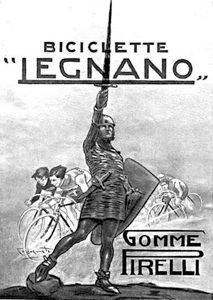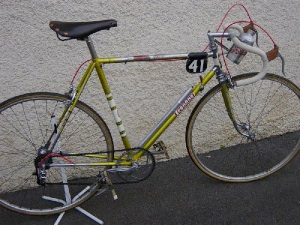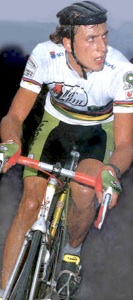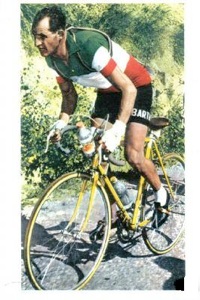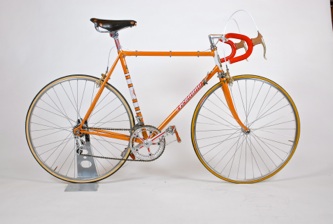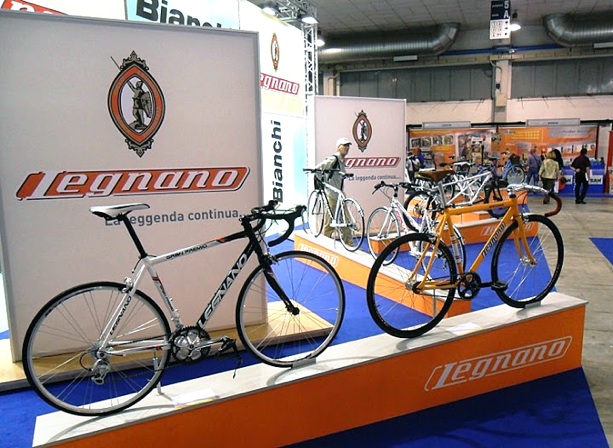Legnano legenden har sitt ursprung i början av förra århundradet. Den första nyheten som refereras till är daterat 1902, då en viss Lignon vinner en landsvägstävling, Val di Taro Cup.
Legnanonamnet lyftes fram ur dimman av myter och blev verklighet 1908, när en viss Emilio Bozzi etablerade företaget "Emilio Bozzi & C.", med avsikten att bygga kompletta cyklar, som engelsmännen redan gjorde vid den tidpunkten. Den första modellen som tillverkades hette Aurora. Efter en tid slog sig Bozzi ihop med Franco Tosi, en affärsman från Legnano, som också såg möjligheter inom cyklarsektorn, och av den anledningen redan hade köpt en del pattenter från det berömd engelsk bolaget, Wolsit.
Vändpunkten kom 1924, då Fascismen var ute efter sporthjältarna och bara ville anlita italienska företag. Bozzi erbjöd ett livstidskontrakt till en ung husmålare, Alfredo Binda, och förändrar företagets varumärke till Legnano. Symbolen är Alberto från Giussano, befälhavaren som kämpade och vann över Federico Barbarossa.
Detta visar sig vara en vinnande strategi. Medan man producerade högkvalitativa cyklar, i fabrikerna gjorde cykelstallet, lett av Edoardo Pavesi, kallad "avucatt" (advokaten) rent hus på cykeltävlingarna.
Detta var Legnanos gyllene år: 6 Världsmästerskap (Binda ensam vinner 3 av dem), 15 upplagor av Giro d'Italia, 2 upplagor av Tour de France och dussintals av andra tävlingar. Binda var Pavesi och Legnanos mest värdefulla tillgång.
Det var under den här tiden rivaliteten med Bianchi börjar växa. Men Pavesi hade ett ess i rockärmen, hans namn var Gino Bartali från Toscana. Gino anlände till Legnano 1936.
Bartali innebar början på en ny gyllene ålder, som övergick i platina när Pavesi, 1939, anställde en ung pojke som bara var skinn och ben. Pojkens namn var Fausto Coppi. Utan att ens inse det, hade Pavesi råkat värva två åkare vars segrar och rivalitet skulle komma att dela Italien i två läger. Den ena var en självsäker pojke från landet, medan den andre var en modernare och elegantare yngling.
Fram till 1942, triumferade Gino och Fausto konsekvent över sina motståndare, men de två var ständigt i "krig" med var andra. Tyvärr stod det riktiga kriget för dörren, och rivaliteten mellan Gino och Fausto, liksom många andra saker, uppslukades av denna tragiska händelse.
Sista minnet för Legnano fans är när Fausto Coppi fastställde det nya en timmes rekordet på Vigorelli velodromen i Milano, mitt under fiendens häftiga bombningar. Och naturligtvis gjorde han det på en Legnano cykel.
Under efterkrigstiden behövde Italien hjältar mer än någonsin, och landet fann dem i cykelvärlden: hjältarna var Gino och Fausto, som hade återvänt och återigen blomstrar deras rivalitet. Fausto har bytt stall och tävlade nu på en Bianchi cykel.
Men Bartali är Bartali, och hans seger i Tour de France 1948 är en historisk bedrift 10 år efter hans första Tour seger. Historien säger att denna seger togs för att rädda Italien från inbördeskrig när kommunistpartiets ledare Togliatti utsattes för ett mordförsök och landet behövde något annat att tänka på en inre strider.
Andra segrar följde. Den senaste, i kronologisk och inte prestigemässig ordnig, var 1956 i Melbourne OS, då den unge Ercole Baldini vann. Senare lyckades Baldini också slå Coppis en timmes rekord på en Legnano cykel, en mycket speciell sådan med extremt låg vikt.
I mitten av 70-talet mördades Bozzi av Röda Brigaden som då härjade villt i Italien och detta blev början till slutet för Legnano som självständigt märke.
1987, steg rivalen Bianchi in, och de vita & Celeste övertog de olivgröna.
Man gjorde ytterligare ett inhopp i tävlingsverksamheten när man ställde upp med cyklar till proffsstallet Alfa Lum – Ecoflam med stjärnan Maurizio Fondriest
1988. Vilket resulterade i ytterligare en världsmästartitel.
